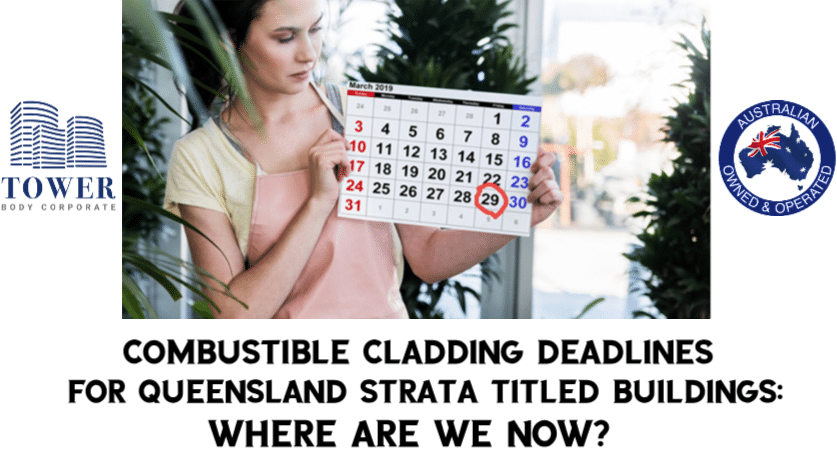Safety concerns regarding cladding in apartment buildings have come into sharp focus over the past few years. To quickly bring you up to speed, on the 1st October 2018 the Queensland State government brought in legislation to tackle the cladding crisis with a three-part compliance plan to be overseen by Safer Buildings at the Queensland Building and Construction Commission (QBCC).
The plan applies to all buildings built after 1 January 1994 and before 1st October 2018 where separate lots are located above or below each other (technical classification is class 2 – 9, construction type A or B).
The intention behind the classification process is to filter out properties that are freestanding or separated by a firewall, such as townhouses or villas. Multilevel buildings such as apartments, offices, warehouses, hospitals, motels and hostels must take part in this process.
Deadlines have been set for each of the three parts of the plan, and at the time this article was written, the deadline for both parts 1 and 2 have passed. Due to the potential for hefty fines, it is recommended that all building owners or agents contact Safer Buildings at the QBCC if they have failed to undertake parts 1 and 2.
Combustible Cladding Deadlines for Queensland Strata Buildings: Where are we now?
Stage 1 – The intention of stage 1 was to filter outbuildings that simply did not have flammable cladding. By the end of stage 1, over 19,000 buildings had been registered, of that total more than 3000 buildings were required to progress to stage 2. The stage 1 deadline was 29th March 2019.
Stage 2 – Requires the affected buildings to engage an industry professional such as a fire engineer to assess whether the building contains potentially flammable materials. Buildings deemed to be potentially affected by flammable cladding were required to then progress to stage 3. The stage 2 deadline was 31st July 2019.
Stage 3 – This final stage consists of two parts, a and b, and required an affected building to engage a fire engineer to undertake an independent cladding risk assessment.
Part 3a required a fire engineer had been engaged and evidence of this was provided by 31st October 2019.
Part 3b (Due 3rd May 2021) requires the building to have obtained the cladding risk assessment as well as some additional reporting requirements. The assessment will take into account not only the type, form, location, and volume of flammable cladding, but also other factors relating to a building’s overall fire performance, such as what active and passive fire measures exist, the risk of injury or death through matters such as smoke inhalation, fallings debris and more.
The outcome of this assessment will decide whether or not an affected building can exit the process with no further works required, or whether works must be undertaken, such as removal and replacement of flammable cladding or installation of other fire protection measures.
Where the assessment finds a building to have a cladding fire risk, there is a further requirement to display a notice and provide notification to all lot owners and some third parties advising the building is considered a cladding fire risk. This ensures that all relevant parties are made aware of the potential risk posed by the cladding, such as prospective purchasers.
For more detailed information on the QBCC Safer Buildings cladding process, please refer to this guide: Guideline for accessing buildings with combustible cladding.
State of play
At the time of writing this article (Sept 2020), the deadlines for stages 1, 2 and 3a have passed and part 3b is required to be completed by 3rd May 2021. In summary, if the process has been followed, building owners have or will discover their building has no cladding fire risk, or, there is a cladding fire risk and action must be taken.
For any building owner or agent who has either not commenced this process or has fallen behind, the potential for penalties is very real and is detailed in the legislation. More importantly, the risk of having a building with potentially fatal flammable cladding is very real. Take action, and take action today.
A cladded cat amongst the pigeons
No doubt there will be some who may wish to challenge works that are outlined in the fire engineer’s cladding risk assessment. This is a decision which should not be made lightly, and a subject that would require legal advice and careful consideration.
It would also be prudent to weigh up the severity of the risk, as well as the cost to benefit of challenging a fire engineers findings against the cost and benefit of simply completing the work.
Furthermore, what are the insurance implications? Is it worth paying a lawyer and additional experts to try and challenge a recommendation, or will the cost of this challenge exceed the cost of simply completing the work? Let’s not forget the benefit which will be gained by a building’s occupants when fire safety measures are upgraded, not to mention a more sound nights sleep for all lot owners, residents, and strata managers.


2 replies on “Combustible cladding deadlines for Queensland Strata Buildings: Where are we now?”
[…] Combustible Cladding and Strata Buildings in Queensland: Where are We Now?Property Owner registration and completion of the checklist for the ‘cladding deadline’ looms in Queensland and NSW.https://towerbodycorporate.com.au/combustible-cladding-deadline-strata-buildings-queensland/ […]
AS1530.1 combustion test is not adequate to determine the safe use of cladding material for high rise. Aluminium is deemed Non-combustible but
failed the AS5113-2916 2kg debris drop test according to Australian Standard. Watch video link below. Solid aluminium cladding should have a height limit and any cladding above this limit should be tested and pass the AS5113-2016 Full wall test